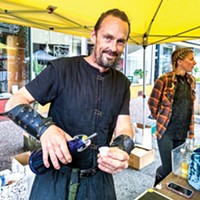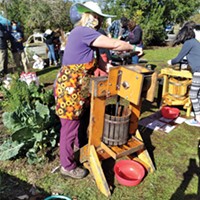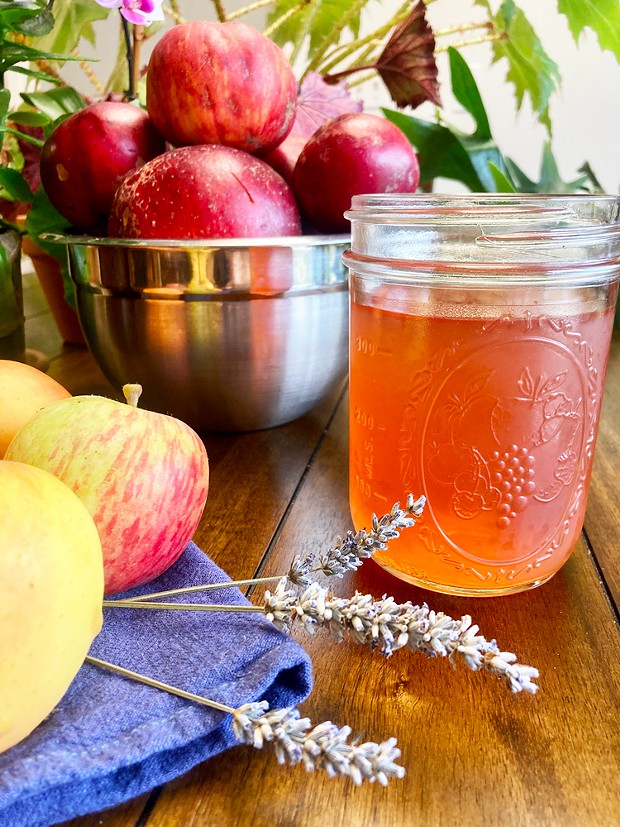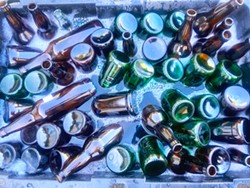[
{
"name": "Top Stories Video Pair",
"insertPoint": "7",
"component": "17087298",
"parentWrapperClass": "fdn-ads-inline-content-block",
"requiredCountToDisplay": "1"
}
]
I never would have called myself a wildcrafter before moving to Humboldt. The sprawling suburbs of Southern California's desert valley where I grew up weren't exactly foraging-friendly. But once you move here, nature has a way of enrapturing not only the curious, but the hungry and thirsty, too.
I spent my first few years in Humboldt exploring, learning the names of local trees and plants, eventually graduating to foraging edible local mushrooms. But my fourth year in Humboldt was when the cider stars aligned. That year brought me Rose and a new house with an old apple tree.
Rose Stone was a coworker when we met one winter. She's an adventurer, a creator of art and delicious food, and a wanderer. She wasn't from here, yet she seemed so distinctly Humboldt. We journeyed into the forest together to find chanterelles and wildcrafting became a core part of our friendship while our lives briefly intersected. She gave me many gifts before wandering off to the next place, one being her cider recipe — her solution to my surplus of Gravensteins from the apple tree in Dan's and my new backyard.
Rose was the first in a cascade of new friends who would ultimately become my extended brewing family. She introduced me to the Humboldt Wildcrafting Facebook community. There, we met Sarah. Borok, synonymous with apples around town, and one of only a few people around Humboldt who makes her apple grinder and presses available to the public ("Apples and Apples," Nov. 26, 2020). She's a community fixture at the Kneeland Glen Farmstand and the Medieval Festival of Courage with her signature aprons and handmade wooden presses. She helps a community of curious folks prevent food from going to waste; even local pigs benefit from the delicious apple leavings post-press. To process apples with her is to feel at peace and better connected to the natural world. Even the yellow jackets joining Sarah's cider pressings call a temporary armistice; they're too distracted to wage war with all the sweetness in the air.
The cider stars continued to align when I met Aaron Weshnak, the head brewer from Dokkaebier and former brewer at The Booth. The past few years of our friendship have been peppered by random texts and phone calls asking if my yeast is angry or if I've lost a batch. It's somehow easier on the spirit when a friend like him tells me that, yes, I have lost four gallons to mold. And then there's Kenny Berry, the brewstore owner who treats everyone like an old friend even if you only see him a couple times a year. He sells supplies but shares his knowledge for free. That's the thing about wildcrafters, fermenters and foragers: We just want to share our craft and we feel kindred with anyone curious.
And people really are curious, excited at idea of their apples being crafted into something fizzy, delicious and a little boozy. Friends who might otherwise leave their apples to fall and fertilize their mother tree generously trade me their harvests each year in exchange for a drink or three. Some of these friends have old trees that have seen Humboldt change through the decades, trees selected, grafted and trellised with hopes for the fruit they'd bear for generations to come. It makes me consider not only my sense of community in the present, but a sense of Humboldt's community history, too.
One of the unique apples I've tasted and brewed is the pink pearl variety bred by Humboldt's own Albert Etter in the 1940s. The pink flesh is otherworldly — sweeter than most, prettier than all. Fifty pounds of perfect pink pearls were donated to me from Tyler Pitts, whose tree, old and full, sits on family land going back five generations. Seeing him glean apples from way up in his trees makes me ponder all the people who have eaten from those trees over the years and all of the people who will drink my cider this next year, and for who knows how many years to come.
Wildcrafting is a labor of love. Transforming fresh juice into hard cider takes time, hard work and curiosity. It takes some good friends to help bottle, too — friends for whom Dan and I are grateful. There are so many ways to experiment with methods and yeasts, and you feel a sense of pride and resourcefulness taking a wild thing and fermenting it safely and deliciously. But it's more than just making apple hooch, it's cultivating community in drinkable form.
Easy Hard Cider
Pick your apples and determine how much cider you'll end up with. A good rule of thumb is 1 gallon of cider from every 15-20 pounds of apples, depending on their juiciness. With this estimate, head down to Humboldt Beer Works and buy a carboy container, an airlock, a stopper, pectin, yeast and Star San sanitizer. Get a few food-grade, 5-gallon buckets with lids, too.
Remember the mantra that will make the whole project smooth sailing: Sanitize everything. Cider ferments over a few weeks, so you don't want any pathogens getting a head start on your yeast. Sanitize bucket No. 1 and a lid (to hold your juice). Sanitize bucket No. 2, then fill it with plain water.
Fill bucket No. 3 with 4 gallons of water and a ½ ounce of bleach. Dunk the apples in the bleach solution for 30 seconds, then rinse in bucket No. 2. Immediately grind and press the apples (or use a juicer for small amounts). Collect the juice in bucket No. 1.
Now you're ready to pour your juice into a carboy to begin fermentation. Sanitize your carboy (and its lid, if it has one), the airlock and stopper. Fill the carboy with juice, about 80 percent full. Now you're ready to pitch the yeast — that's brew-speak for "throw it in." For higher alcohol content, you can add a simple solution of sugar and water when pitching the yeast. The more sugar, the higher the alcohol content will be. Add pectin for clarity. Fill the airlock with Star San, and find a cool, dark place for the cider to ferment.
And now, you wait. The yeast will begin bubbling almost immediately and foam may form on the cider's surface, so watch the airlock for overflow in the first few days. After three to five weeks, depending on desired sweetness and alcohol content, it's time to bottle and carbonate. Longer fermentation time yields higher alcohol content. Shorter ferments make sweeter cider.
Bottle the cider in — you guessed it — sanitized bottles, dropping priming tablets in each for fizz. Top the bottles with sanitized caps and store for two more weeks as the liquid carbonates. Finally, chill, serve, toast your community and congratulate yourself on being brewmaster of the universe.
Jessica Ashley Silva (she/her) is a foodie, wildcrafter and creative writer focusing on food and cannabis. She works as a technical writer in Arcata's Cannabis Innovation Zone.
Speaking of...
-

Say Skol to Norseman Mead
Oct 19, 2023 -

NCJ Preview: Nuclear Legacy, a Police Chief Retires and Brewing Cider
Nov 6, 2021 -

Apples and Apples
Nov 26, 2020 - More »
more from the author
-
Fungi for All Seasons
In puff pastry and quiche
- Jul 13, 2023
-
Gettin' Saucy with Pot Wings
Infused honey-lime chipotle and Buffalo
- Mar 16, 2023
-
Rise of the Cannabis Mocktail
- Mar 17, 2022
- More »

































